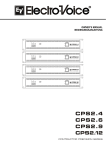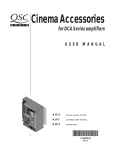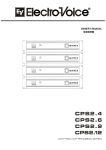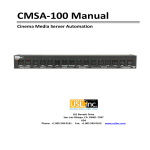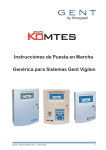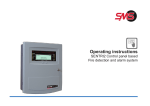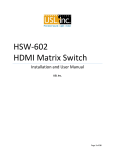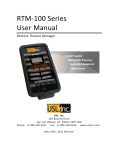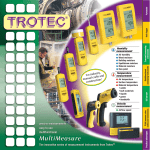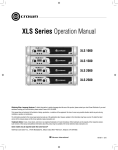Download Usl CM Series Specifications
Transcript
Ultra Stereo Labs, Inc. Specifications Inputs Processor: Eight inputs corresponding to left, center, right, surround left, surround right, back surround left, back surround right and subwoofer. Input impedance is 10k . Power Amplifiers: Eleven inputs corresponding to left hi and lo, center hi and lo, right hi and lo, surround left, surround right, back surround left, back surround right and subwoofer. Input impedance is greater than 50K Controls Front Panel: Individual push button switches for each input channel toggle on and off so that channels may be monitored in any combination. An LED indicator illuminates when the corresponding channel is selected. A volume control sets the speaker output level and works independently of the front panel VU bargraph meter. A push-button switch with corresponding LED switches monitoring between the Processor and Amplifier inputs. A 12-segment bargraph VU Meter indicates the input level from -40 to +3 VU. Rear Panel: Three trimpots adjust the processor, amplifier and VU meter input levels. Power Requirements 100-300VAC, 50-60Hz, 32 Watts Construction The CM-680 Monitor is constructed of steel to minimize hum pickup and noise radiation. The overall size of the unit is 3.5" x 19" x 9.625". The CM-680 is designed to mount in a standard rack frame or cabinet. CM-680 Weight: 10 lbs. 2 oz. (4.63 kg) Shipping weight: 16 lbs. (7.26kg) Shipping Size: 22 x 22 x 6 (558.8 x 558.8 x 152.4 mm) 181 Bonetti Drive, San Luis Obispo, CA 93401 ph: 805-549-0161 fax: 805-549-0163 e-mail:[email protected] 2002 All Rights Reserved 7/25/02 - 15 - CM-680 Monitor / Crossover INSTRUCTION MANUAL CM-680 INSTRUCTION MANUAL 181 Bonetti Drive San Luis Obispo, CA 93401 ph: 805-549-0161 fax: 805-549-0163 e-mail:[email protected] CM-680 INSTRUCTION MANUAL Ultra Stereo Labs, Inc. CM-680 INSTRUCTION MANUAL Ultra Stereo Labs, Inc. Figure 8 One Year Limited Warranty BYPASS FOR PASSIVE OR EXTERNAL CROSSOVER SWITCHES A-C ON ** ON 1 USL, Inc. warrants that each product manufactured by it will be free from defects in material and workmanship under normal usage for a period of one (1) year after its purchase new from an authorized dealer. Our obligation under this warranty is limited to repairing or replacing any product or component which we are satisfied does not conform with the foregoing warranty and which is returned to our factory, freight paid, or serviced by one of our authorized contractors. The forgoing warranty is exclusive and in lieu of all other warranties, whether expressed or implied. Such warranty shall not apply to any product or component (A) repaired or altered by anyone other than USL, Inc. or an authorized service contractor; (B) tampered with or altered in any way or subjected to misuse, negligence or accident or (C) which has been improperly connected installed or adjusted other than in accordance with USL, Inc.s instruction. -1- ON 1 2 SWITCH A ON 1 2 SWITCH B 2 SWITCH C ON 1 2 3 4 SWITCH D 1 2 3 4 SWITCH E 1 2 3 4 SWITCH F TO USE DOLBY CP650 CROSSOVERS SWITCHES D-F ON ** NOTE: TO FEED ONLY CHANNEL 1 OF THE HD15 CABLE IN THE BYPASS MODE TURN ON ONLY THE FOLLOWING: SWITCH A 1&2, SWITCH B 1&2, SWITCH C 1&2 - 14 - CM-680 INSTRUCTION MANUAL Ultra Stereo Labs, Inc. Figure 7 Speaker Crossover Frequency Time Delay JBL 4675D JBL 4670 JBL 5671 JBL 5672 JBL 5674 500Hz 800Hz 330Hz 297Hz 297Hz 1.8ms. 0.7ms, 1.4ms 1.8ms. 1.8ms EV TS940 EV TS992LX EV 9040 EV Variplex 800Hz 500HZ 500Hz 330Hz 0.7ms. 1.8ms. 1.8ms 1.4ms EAW CB2591 EAW CB259 EAW CB253 500Hz 800Hz 350 1.8ms 0.7ms 0.7ms 1. Bypass Card XTB-680: When using external crossovers, the CM-680 must be equipped with a bypass card in the crossover slot. For connection to a CP-650, slide dip switches D,E, & F on the XTB-680 to the ON position. When using other electronic crossovers or speakers with passive crossovers, turn DIP switches A,B & C to ON. See figure #8 Connect crossover inputs to rear of CM-680 at Ll, Cl &Rl as per Fig.4 (Page9) - 13 - CM-680 INSTRUCTION MANUAL Ultra Stereo Labs, Inc. Table of Contents Introduction .........................................................3 Front & Rear Panel Description............................5 Installation............................................................7 Crossover Setup...................................................11 Please record the following information for your records: Model: ___________________ Serial Number: ___________ Date of Purchase: __________ Purchased from: __________ -2- CM-680 INSTRUCTION MANUAL Ultra Stereo Labs, Inc. Introduction CM-680 INSTRUCTION MANUAL Ultra Stereo Labs, Inc. Figure 6 Please read this entire manual before commencing your installation. -3- Wire Strippers 1.8ms 800hz 500hz Llo Lhi Clo Chi Rlo Rhi RIGHT Screen EQ 4-6 On/Off HORN EQ 1-3 ON Horn EQ 1-3 On/Off Crossover Output Levels No. 2 Phillips screwdriver CENTER Bypass Xover Levels Normal/Bypass Switch and LEDs - 12 - SCREEN EQ 4-6 ON Small, standard screwdriver Trimpot adjustment tool 1.4ms 1.8ms 800hz LEFT 330hz All Switches On: 330 Hz CROSSOVER FREQUENCY 1.4ms 1.8ms 1.4ms All Switches On: 500 Hz RIGHT 500hz All Switches Off: 297 Hz CENTER 330hz All Switches On: 800 Hz LEFT 800hz All Switches Off: 0.7ms All Switches On: 1.8ms All Switches On: 1.4ms 500hz TOOLS REQUIRED TIME DELAY 330hz The Ultra Stereo CM-680 Projection Booth Monitor has been designed for high performance, ease of use, and years of trouble free service. Installation and setup of the monitors has been considerably simplified. No special tools are required. The built in VU meter and test jack give the technician immediate information about the status of the processor and all power amplifiers. All controls necessary for daily operation of the processor are easily accessible on the front panel. The components that make up the CM-680 monitors are of computer grade for reliability. All front panel controls are individually sealed for long life. All Ultra Stereo equipment has been burned-in at the factory for an extended period in order to eliminate the possibility of premature failure. Unpack the unit carefully. If the container has been damaged, thoroughly inspect the equipment to make certain that there is no hidden damage. File a claim immediately with the carrier if any damage is found. Also advise your dealer or the factory. CM-680 INSTRUCTION MANUAL Ultra Stereo Labs, Inc. CM-680 INSTRUCTION MANUAL Ultra Stereo Labs, Inc. Crossover Setup Analog Crossover Card XTA-680: When using the USL, Inc. Crossover card, the following parameters must be set: time delay, crossover frequency, horn EQ, Screen EQ and output levels. See figure #6. Make sure the NORMAL/BYPASS switch is set in the NORMAL position. Determine the model number of the speaker system being used. (Figure #7 has a listing of several popular cinema loudspeakers.) If your loudspeaker requires a 1.8 ms delay, turn ON all DIP switches on the first row marked 1.8 ms. Refer to figure #7. Likewise a loudspeaker requiring 1.4 ms delay should require all the DIP switches in the second row to be turned ON. For loudspeakers requiring only 0.7 ms delay, leave all the time delay DIP switches OFF. Never turn on both rows of time Delay switches! Next, set the crossover frequency. For 800Hz, turn all the crossover frequency DIP switches in the first row ON. For 500Hz, turn all the DIP switches in the second row ON. For 330Hz, turn all the DIP switches in the third row ON. For 297 Hz, leave all the crossover frequency DIP switches OFF. Never turn on more than one row of DIP switches. Now, set the horn EQ and screen EQ DIP switches. Generally, all six DIP switches should be ON. In some cinemas, the left and right speakers are mounted outside the screen area. In this case, turn the left and right screen EQ switches to OFF. Some high frequency horns are very flat to 20kHz. In this case, you may want to turn the horn EQ switches to OFF. The horn and screen EQ each provide about 8dB of boost at 20kHz. The combination of horn and screen EQ results in about 16 dB boost at 20kHz. You will need to supply the following materials: Shielded audio cable for connecting the CM-680 to the cinema processor and power amplifier outputs. Four 10-32 x 1/2" screws to mount the CM-680 in the audio equipment rack. FEATURES The CM-680 monitor has the following standard features: Eight-Channel Monitoring - allows you to monitor either the processor or power amplifier outputs to left, center, right, surround left, surround right, back surround left, back surround right and subwoofer channels, in any combination via the switch on the front panel (see illustration on pg. 5 - switch 5) Input levels from processor and power amplifier can be adjusted independently - no huge level jumps when switching between processor and power amplifiers. Bargraph display may be calibrated to the reference level for your theatre the projectionist can see auditorium levels instantly. Designed to work with bi-amplified sound systems to monitor the high and low frequency outputs from the left, center and right channels. Finally, set the output levels. Using a Real Time Analyzer and feeding a pink noise signal from the cinema processor, set the appropriate ten turn pots for a flat response around the crossover frequency and a total SPL level of 85 on each of the front three channels. There should be enough range in the output pots to allow setting the amplifier gains at maximum or at the 12 Oclock position. The bypass crossover is fixed at about 500 Hz with no time delay. Using a Real Time Analyzer and feeding pink noise from the center channel of the cinema processor, set the bypass levels for flat response around 500 Hz and an SPL level of 85. The NORMAL/BYPASS switch will need to be set in BYPASS. - 11 - -4- CM-680 R Rs 2 CHANNEL SELECT Ls EIGHT CHANNEL MONITOR/XOVER C BSl 3 BSr SW 4 5 PROCESSOR AMPLIFIERS 10 0 VOLUME 9 8 1 2 6 7 4 3 5 -40 -30 -20 -10 -7 -5 -3 -1 0 +1 +2 +3 6 VU 7 TEST 8 9 POWER Figure 1 1. Channel select buttons - pressing a Channel Select Button causes the corresponding LED to illuminate and the signal from that channel to be monitored. Any combination of eight channels can be selected. 2. Internal Digital or Analog Crossover Access Cover. 3. Crossover Bypass Switch - Switching this will cause the internal crossover to be bypassed or engaged and the condition will be indicated by its appropriate LED. 4. Volume Control - controls the volume of the internal or external speaker. The volume control has no effect on the VU Bargraph display. 5. Processor/Amplifier Selector Switch - selects either the inputs from the cinema processor or power amplifiers for monitoring. 6. VU Bargraph - displays the level of the selected channels. The VU Bargraph may be calibrated by the rear panel trim adjustment (Figure 2). The VU Bargraph operates independently of the volume control (4). 7. Test Jack - permits monitoring of the audio output of the CM-680. Inserting a mono or stereo 1/4 phone plug here disables the internal speaker and routes the audio output to the Test Jack. Do not connect any device here with less than 8 Ohms impedance. 8. Internal Speaker 9. Power Switch 1 L CM-680 Front Panel CM-680 INSTRUCTION MANUAL Ultra -5- Stereo Labs, Inc. CM-680 INSTRUCTION MANUAL Pin # Name 1 2 3 Band A (1), Signal NC Band A, Vmon (Amp returns) 4 5 Band A, Imon NC 9 10 Pin # Ultra Main Processor Outputs Pin # Function Function 1 2 3 4 5 6 7 8 9 10 11 12 13 14 15 16 17 18 19 20 21 22 23 24 25 GND Left N/C N/C Center N/C N/C Right N/C GND GND GND N/C GND Left LF Left HF GND Right LF Right HF GND Center LF Center HF Surr L Surr R Sub N/C N/C Bsl N/C N/C Bsr Chassis Gnd N/C N/C Ls Rs N/C N/C N/C N/C Bsl + N/C N/C Bsr + N/C N/C N/C Ls + Rs + N/C - 10 - Stereo Labs, Inc. Setting Monitor and Bargraph Levels: Set the processor main fader and amplifier levels so the house speakers are playing back at the normal listening level. Select some source material like pink noise. Set the Processor/Amplifier switch to Processor. With the monitor volume to 7, adjust the Processor trimpot for a comfortable listening level. Set the bargraph trimpot for a reading in the middle range. Set the Processor/Amplifier switch to Amplifier, adjust the amplifier trimpot so the level matches the processor level. DB-25 Connector Pinout Optional Processor Outputs Figure 5 CM-680 HD 15 pin outs Name Typical per connector Pin # Name 6 Chassis Gnd 11 7 8 Band A (1), + Signal Band B (2), + Signal 12 13 Band B (2), Signal NC Band B, Vmon (Amp returns) NC Signal Ground 14 15 Band B, Imon NC PROCESSOR LEVEL Bsr- Sw E 1/2 15 Sw2Cl E Ch 15 E WARNING: UNITS EQUIPPED WITH INTERNAL BYPASS CARD MUST HAVE INTERNAL DIP SWITCHES SET FOR PROPER CONFIGURATION 12VAC @250mA BYPASS POWER L R L Biamp L R C Biamp L R R Biamp L R Sw Amp L R Ls/Rs Amp L R Bsl/Bsr Amp AMPLIFIER LEVEL COM COM 15 E PROCESSOR LEVEL Bsr- Bsl Bsr 15 Sw2E Sw 1/2 Sw2+ 1 15 ChE Cl Ch Ch+ Cl1 Sw1Bsr+ BslRh Rl Sw+ Sw- Cl+ Swl+ Bsl+ COM Ch- COM 1 1 3 ON 2 4 1234 1 3 ON 2 4 5678 ON 1 WARNING: UNITS EQUIPPED WITH INTERNAL BYPASS CARD MUST HAVE INTERNAL DIP SWITCHES SET FOR PROPER CONFIGURATION 12VAC @250mA BYPASS POWER SWITCHES 1-4 ON NORMAL Ls/Rs SWITCHES 5-8 ON EX CHANNELS Ls/Rs/Bsl/Bsr MAIN INPUTS FROM PROCESSOR OUTPUTS 25 BARGRAPH LEVEL 25 OPTIONAL INPUTS FROM PROCESSOR OUTPUTS Figure 4 1 2 3 4 5 6 7 8 9 10 11 12 13 14 15 16 17 18 19 1. Main AC connector with fuse. 2. Amplifier outputs - connect to the power amplifier speaker outputs corresponding to Ls, Rs, Bsl, Bsr and Sw channels. 3. Amplifier outputs - connect to the power amplifier speaker outputs corresponding to Lh, Ll, Ch, Cl and Rh, Rl. 4. Amplifier level - this trimpot adjusts the level of the input lines coming from the Power Amplifiers. 5. HD-15 connector - connect to Ls/Rs amplifier. 6. HD-15 connector - connect to Bsl/Bsr amplifier. 7. Processor level - this trimpot adjusts the level of the input lines coming from the processor. 8. Crossover outputs - connect to the power amplifier inputs corresponding to Ls, Rs, Bsl and Bsr. 9. HD-15 connector - connect to Rl/Rh amplifier. 10. HD-15 connector - connect to Sw amplifier. 11. Crossover outputs - connect to the power amplifier inputs corresponding to Rl, Rh and Sw. 12. HD-15 connector - connect to Ll/Lh amplifier. 13. HD-15 connector - connect to Cl/Ch amplifier. 14. Crossover outputs - connect to the power amplifier inputs corresponding to Ll/Lh and Cl/Ch amplifier. 15. Optional input - connect these to the EX outputs of the processor 16. Bargraph level - this trimpot adjusts the sensitivity of the front panel VU Bargraph. 17. Main input - connect this to the main outputs of the processor. 18. AC Emergency power input - 12-16VAC, 0.5A 19. EX Selector switch - without EX, turn on 1-4 switches. With EX, turn on 5-8 switches. This routes the correct Ls/Rs inputs to the CM-680 circuitry. NOTE: There are two identical subwoofer outputs (SW1 & SW2) which can be used 1 SWITCHES 1-4 ON NORMAL Ls/Rs E 1 Lh- ON Lh+ 5678 15 1234 Lh 25 E Ch+ Rh- Cl+ SWITCHES 5-8 ON EX CHANNELS Ls/Rs/Bsl/Bsr Rh+ Cl- 25 15 E 4 Rh Lh3 E 15 ON Rs- 1 2 Rs+ Sw2+ 1 15 Swl+ 4 Rs Sw1- 3 Ch E ON Ll- Rh2 230V -9- 15 1 115V 15 1 1 RISK OF FIRE OR ELECTRIC SHOCK DO NOT EXPOSE THIS A P P L I A N C E TO R A I N O R MOISTURE. DO NOT REMOVE COVER. NO USER SERVICEABLE PARTS INSIDE. REFER SERVICING TO QUALIFIED PERSONNEL. FOR CONTINUED PROTECTION AGAINST FIRE OR SHOCK HAZARD REPLACE ONLY WITH THE SAME FUSE TYPE AND RATING. Bsr E OPTIONAL INPUTS FROM PROCESSOR OUTPUTS Cl Bsr+ BARGRAPH LEVEL COM Bsl+ Lh+ WARNING: TO REDUCE THE AMPLIFIER LEVEL Bsl- Ll- Bsr Bsl Rs- Ll+ Bsl COM 15 1 COM COM 1 Ll MONITOR/CROSSOVER Rh Lh 90-240VAC 50-60 Hz Rl Rh+ Rl- Ch Rl- Ls- COM SwRl+ Ls COM Sw+ 1 Lh Cl Bsr Rl Rs Bsl Rh Ll Rs+ Ls+ Rl CROSSOVER OUTPUTS TO POWER AMPLIFIER INPUTS CM-680 1 Ll+ Ls- Rs 1 230V RISK OF FIRE OR ELECTRIC SHOCK DO NOT EXPOSE THIS A P P L I A N C E TO R A I N O R MOISTURE. DO NOT REMOVE COVER. NO USER SERVICEABLE PARTS INSIDE. REFER SERVICING TO QUALIFIED PERSONNEL. FOR CONTINUED PROTECTION AGAINST FIRE OR SHOCK HAZARD REPLACE ONLY WITH THE SAME FUSE TYPE AND RATING. Ls COM Rl+ WARNING: TO REDUCE THE Lh 1 90-240VAC 50-60 Hz Ll COM Ls+ 115V Ls Rs CROSSOVER OUTPUTS TO POWER AMPLIFIER INPUTS MONITOR INPUTS FROM DB-25 Cables 1 MAIN AUDIO OUTPUTS Ll CM-680 OPTION CARD I/O Figure 2 TERMINAL WIRING DIAGRAM Ls Cinema Processor Stereo Labs, Inc. MONITOR INPUTS FROM MONITOR/CROSSOVER Ultra CM-680 Rear Panel CM-680 INSTRUCTION MANUAL CM-680 INSTRUCTION MANUAL Ultra -6- Stereo Labs, Inc. CM-680 INSTRUCTION MANUAL Ultra Stereo Labs, Inc. CM-680 INSTRUCTION MANUAL Ultra Stereo Labs, Inc. Figure 3 Installation SIMPLE WIRING DIAGRAM WITH HD-15 CONNECTORS Mount the CM-680 The ideal place for the CM-680 Monitor is in the sound rack or projector console between the stereo processor and power amplifiers. DB25 and HD15 connectors are available on the back plane to make installation quick and easy. Alternatively, terminal blocks allow the use of stripped and tinned wire. They are pluggable for easy service and trouble shooting. MAIN AUDIO OUTPUTS DB-25 Cables Note: Amplifier output terminal blocks are NOT used when VGA cables are used MONITOR INPUTS FROM CROSSOVER OUTPUTS TO POWER AMPLIFIER INPUTS 1 Monitor Hookup CM-680 MONITOR/CROSSOVER 90-240VAC 50-60 Hz 2. Monitor Inputs From Processor Outputs: Use the male-female 25 pin D cable to connect the output of the cinema processor to the main input of the CM-680. If EX channels are to be used, then plug an additional male-female 25 pin D cable from the Optional Outputs at the processor to the Optional Inputs of the CM-680. NOTE: you must select EX or NORMAL (non EX) channel routing using the DIP switches on the rear panel of the CM-680. 115V 230V 1. Power: Connect the unit to the AC power outlet using the standard IEC cable provided. Any power source from 100-300VAC, 50-60 Hz will be sufficient. WARNING: TO REDUCE THE RISK OF FIRE OR ELECTRIC SHOCK DO NOT EXPOSE THIS A P P L I A N C E TO R A I N O R MOISTURE. DO NOT REMOVE COVER. NO USER SERVICEABLE PARTS INSIDE. REFER SERVICING TO QUALIFIED PERSONNEL. FOR CONTINUED PROTECTION AGAINST FIRE OR SHOCK HAZARD REPLACE ONLY WITH THE SAME FUSE TYPE AND RATING. 1 Ls+ Ls Ll Rs Lh Ls Ls- COM COM Rs Rs+ Bsl Cl Bsr Ch COM COM Sw+ Rl Sw- Rh COM COM AMPLIFIER LEVEL 15 RlRh+ 15 E 1 Ll+ Ll Lh+ Rh- 15 E Lh- 3 SWITCHES 5-8 ON EX CHANNELS Ls/Rs/Bsl/Bsr ON 4 1 2 3 4 5678 ON 1 25 Sw Sw2- Cl Ch- Bsr E 1/2 E Ch E 15 2 15 WARNING: UNITS EQUIPPED WITH INTERNAL BYPASS CARD MUST HAVE INTERNAL DIP SWITCHES SET FOR PROPER CONFIGURATION L Biamp VGA Cables C Biamp R Biamp Sw Amp Ls/Rs Amp 4. Monitor Inputs From Power Amplifier Outputs: When VGA cables are NOT being used, the amplifier outputs must be connected to terminal blocks 2 & 3. Unshielded wire can be used to connect the output of the amplifiers to the appropriate monitor speaker. Inputs on the rear panel of the CM-680: All of these inputs are unbalanced except for the subwoofer. See figure #2 Bsl/Bsr Amp -8- SWITCHES 1-4 ON NORMAL Ls/Rs Ch+ Bsr- PROCESSOR LEVEL ON 1 1234 E Cl- 1 Sw2+ Bsl 15 BARGRAPH LEVEL Cl+ Sw1- 1 Bsr+ 25 Ll- Lh Swl+ Bsl+ Bsl- 1 OPTIONAL INPUTS FROM PROCESSOR OUTPUTS 1 Rl+ Rl Rh Rs- 3. Crossover Outputs to Power Amplifier Inputs: The CM-680 utilizes HD15 connectors that mate with several popular amplifiers. Plug one end of the VGA HD15 cable into the chassis connector on the rear of the CM-680. Plug the other end of the cable into the appropriate amplifier. The VGA cable not only sends the CM-680 crossover signal to the amplifiers, but also sends a power amp output signal back to the CM-680 monitor. This vastly simplifies rack wiring. USL, Inc. stocks 2, 4 and 6 long VGA cables. See figure #3 Terminal blocks are also provided on the back of the CM-680 chassis to allow wiring to traditional amplifiers without the HD15 interface. All crossover outputs are balanced. Please use two conductor shielded cable to minimize ground loops and hum. Connect each of the crossover channel outputs to the appropriate amplifier inputs. -7- OPTION CARD I/O Cinema Processor BYPASS POWER 12VAC @250mA CM-680 INSTRUCTION MANUAL Ultra Stereo Labs, Inc. CM-680 INSTRUCTION MANUAL Ultra Stereo Labs, Inc. Figure 3 Installation SIMPLE WIRING DIAGRAM WITH HD-15 CONNECTORS Mount the CM-680 The ideal place for the CM-680 Monitor is in the sound rack or projector console between the stereo processor and power amplifiers. DB25 and HD15 connectors are available on the back plane to make installation quick and easy. Alternatively, terminal blocks allow the use of stripped and tinned wire. They are pluggable for easy service and trouble shooting. MAIN AUDIO OUTPUTS DB-25 Cables Note: Amplifier output terminal blocks are NOT used when VGA cables are used MONITOR INPUTS FROM CROSSOVER OUTPUTS TO POWER AMPLIFIER INPUTS 1 Monitor Hookup CM-680 MONITOR/CROSSOVER 90-240VAC 50-60 Hz 2. Monitor Inputs From Processor Outputs: Use the male-female 25 pin D cable to connect the output of the cinema processor to the main input of the CM-680. If EX channels are to be used, then plug an additional male-female 25 pin D cable from the Optional Outputs at the processor to the Optional Inputs of the CM-680. NOTE: you must select EX or NORMAL (non EX) channel routing using the DIP switches on the rear panel of the CM-680. 115V 230V 1. Power: Connect the unit to the AC power outlet using the standard IEC cable provided. Any power source from 100-300VAC, 50-60 Hz will be sufficient. WARNING: TO REDUCE THE RISK OF FIRE OR ELECTRIC SHOCK DO NOT EXPOSE THIS A P P L I A N C E TO R A I N O R MOISTURE. DO NOT REMOVE COVER. NO USER SERVICEABLE PARTS INSIDE. REFER SERVICING TO QUALIFIED PERSONNEL. FOR CONTINUED PROTECTION AGAINST FIRE OR SHOCK HAZARD REPLACE ONLY WITH THE SAME FUSE TYPE AND RATING. 1 Ls+ Ls Ll Rs Lh Ls Ls- COM COM Rs Rs+ Bsl Cl Bsr Ch COM COM Sw+ Rl Sw- Rh COM COM AMPLIFIER LEVEL 15 RlRh+ 15 E 1 Ll+ Ll Lh+ Rh- 15 E Lh- 3 SWITCHES 5-8 ON EX CHANNELS Ls/Rs/Bsl/Bsr ON 4 1 2 3 4 5678 ON 1 25 Sw Sw2- Cl Ch- Bsr E 1/2 E Ch E 15 2 15 WARNING: UNITS EQUIPPED WITH INTERNAL BYPASS CARD MUST HAVE INTERNAL DIP SWITCHES SET FOR PROPER CONFIGURATION L Biamp VGA Cables C Biamp R Biamp Sw Amp Ls/Rs Amp 4. Monitor Inputs From Power Amplifier Outputs: When VGA cables are NOT being used, the amplifier outputs must be connected to terminal blocks 2 & 3. Unshielded wire can be used to connect the output of the amplifiers to the appropriate monitor speaker. Inputs on the rear panel of the CM-680: All of these inputs are unbalanced except for the subwoofer. See figure #2 Bsl/Bsr Amp -8- SWITCHES 1-4 ON NORMAL Ls/Rs Ch+ Bsr- PROCESSOR LEVEL ON 1 1234 E Cl- 1 Sw2+ Bsl 15 BARGRAPH LEVEL Cl+ Sw1- 1 Bsr+ 25 Ll- Lh Swl+ Bsl+ Bsl- 1 OPTIONAL INPUTS FROM PROCESSOR OUTPUTS 1 Rl+ Rl Rh Rs- 3. Crossover Outputs to Power Amplifier Inputs: The CM-680 utilizes HD15 connectors that mate with several popular amplifiers. Plug one end of the VGA HD15 cable into the chassis connector on the rear of the CM-680. Plug the other end of the cable into the appropriate amplifier. The VGA cable not only sends the CM-680 crossover signal to the amplifiers, but also sends a power amp output signal back to the CM-680 monitor. This vastly simplifies rack wiring. USL, Inc. stocks 2, 4 and 6 long VGA cables. See figure #3 Terminal blocks are also provided on the back of the CM-680 chassis to allow wiring to traditional amplifiers without the HD15 interface. All crossover outputs are balanced. Please use two conductor shielded cable to minimize ground loops and hum. Connect each of the crossover channel outputs to the appropriate amplifier inputs. -7- OPTION CARD I/O Cinema Processor BYPASS POWER 12VAC @250mA PROCESSOR LEVEL Bsr- Sw E 1/2 15 Sw2Cl E Ch 15 E WARNING: UNITS EQUIPPED WITH INTERNAL BYPASS CARD MUST HAVE INTERNAL DIP SWITCHES SET FOR PROPER CONFIGURATION 12VAC @250mA BYPASS POWER L R L Biamp L R C Biamp L R R Biamp L R Sw Amp L R Ls/Rs Amp L R Bsl/Bsr Amp AMPLIFIER LEVEL COM COM 15 E PROCESSOR LEVEL Bsr- Bsl Bsr 15 Sw2E Sw 1/2 Sw2+ 1 15 ChE Cl Ch Ch+ Cl1 Sw1Bsr+ BslRh Rl Sw+ Sw- Cl+ Swl+ Bsl+ COM Ch- COM 1 1 3 ON 2 4 1234 1 3 ON 2 4 5678 ON 1 WARNING: UNITS EQUIPPED WITH INTERNAL BYPASS CARD MUST HAVE INTERNAL DIP SWITCHES SET FOR PROPER CONFIGURATION 12VAC @250mA BYPASS POWER SWITCHES 1-4 ON NORMAL Ls/Rs SWITCHES 5-8 ON EX CHANNELS Ls/Rs/Bsl/Bsr MAIN INPUTS FROM PROCESSOR OUTPUTS 25 BARGRAPH LEVEL 25 OPTIONAL INPUTS FROM PROCESSOR OUTPUTS Figure 4 1 2 3 4 5 6 7 8 9 10 11 12 13 14 15 16 17 18 19 1. Main AC connector with fuse. 2. Amplifier outputs - connect to the power amplifier speaker outputs corresponding to Ls, Rs, Bsl, Bsr and Sw channels. 3. Amplifier outputs - connect to the power amplifier speaker outputs corresponding to Lh, Ll, Ch, Cl and Rh, Rl. 4. Amplifier level - this trimpot adjusts the level of the input lines coming from the Power Amplifiers. 5. HD-15 connector - connect to Ls/Rs amplifier. 6. HD-15 connector - connect to Bsl/Bsr amplifier. 7. Processor level - this trimpot adjusts the level of the input lines coming from the processor. 8. Crossover outputs - connect to the power amplifier inputs corresponding to Ls, Rs, Bsl and Bsr. 9. HD-15 connector - connect to Rl/Rh amplifier. 10. HD-15 connector - connect to Sw amplifier. 11. Crossover outputs - connect to the power amplifier inputs corresponding to Rl, Rh and Sw. 12. HD-15 connector - connect to Ll/Lh amplifier. 13. HD-15 connector - connect to Cl/Ch amplifier. 14. Crossover outputs - connect to the power amplifier inputs corresponding to Ll/Lh and Cl/Ch amplifier. 15. Optional input - connect these to the EX outputs of the processor 16. Bargraph level - this trimpot adjusts the sensitivity of the front panel VU Bargraph. 17. Main input - connect this to the main outputs of the processor. 18. AC Emergency power input - 12-16VAC, 0.5A 19. EX Selector switch - without EX, turn on 1-4 switches. With EX, turn on 5-8 switches. This routes the correct Ls/Rs inputs to the CM-680 circuitry. NOTE: There are two identical subwoofer outputs (SW1 & SW2) which can be used 1 SWITCHES 1-4 ON NORMAL Ls/Rs E 1 Lh- ON Lh+ 5678 15 1234 Lh 25 E Ch+ Rh- Cl+ SWITCHES 5-8 ON EX CHANNELS Ls/Rs/Bsl/Bsr Rh+ Cl- 25 15 E 4 Rh Lh3 E 15 ON Rs- 1 2 Rs+ Sw2+ 1 15 Swl+ 4 Rs Sw1- 3 Ch E ON Ll- Rh2 230V -9- 15 1 115V 15 1 1 RISK OF FIRE OR ELECTRIC SHOCK DO NOT EXPOSE THIS A P P L I A N C E TO R A I N O R MOISTURE. DO NOT REMOVE COVER. NO USER SERVICEABLE PARTS INSIDE. REFER SERVICING TO QUALIFIED PERSONNEL. FOR CONTINUED PROTECTION AGAINST FIRE OR SHOCK HAZARD REPLACE ONLY WITH THE SAME FUSE TYPE AND RATING. Bsr E OPTIONAL INPUTS FROM PROCESSOR OUTPUTS Cl Bsr+ BARGRAPH LEVEL COM Bsl+ Lh+ WARNING: TO REDUCE THE AMPLIFIER LEVEL Bsl- Ll- Bsr Bsl Rs- Ll+ Bsl COM 15 1 COM COM 1 Ll MONITOR/CROSSOVER Rh Lh 90-240VAC 50-60 Hz Rl Rh+ Rl- Ch Rl- Ls- COM SwRl+ Ls COM Sw+ 1 Lh Cl Bsr Rl Rs Bsl Rh Ll Rs+ Ls+ Rl CROSSOVER OUTPUTS TO POWER AMPLIFIER INPUTS CM-680 1 Ll+ Ls- Rs 1 230V RISK OF FIRE OR ELECTRIC SHOCK DO NOT EXPOSE THIS A P P L I A N C E TO R A I N O R MOISTURE. DO NOT REMOVE COVER. NO USER SERVICEABLE PARTS INSIDE. REFER SERVICING TO QUALIFIED PERSONNEL. FOR CONTINUED PROTECTION AGAINST FIRE OR SHOCK HAZARD REPLACE ONLY WITH THE SAME FUSE TYPE AND RATING. Ls COM Rl+ WARNING: TO REDUCE THE Lh 1 90-240VAC 50-60 Hz Ll COM Ls+ 115V Ls Rs CROSSOVER OUTPUTS TO POWER AMPLIFIER INPUTS MONITOR INPUTS FROM DB-25 Cables 1 MAIN AUDIO OUTPUTS Ll CM-680 OPTION CARD I/O Figure 2 TERMINAL WIRING DIAGRAM Ls Cinema Processor Stereo Labs, Inc. MONITOR INPUTS FROM MONITOR/CROSSOVER Ultra CM-680 Rear Panel CM-680 INSTRUCTION MANUAL CM-680 INSTRUCTION MANUAL Ultra -6- Stereo Labs, Inc. CM-680 INSTRUCTION MANUAL Ultra Stereo Labs, Inc. Setting Monitor and Bargraph Levels: Set the processor main fader and amplifier levels so the house speakers are playing back at the normal listening level. Select some source material like pink noise. Set the “Processor/Amplifier” switch to “Processor”. With the monitor volume to “7”, adjust the “Processor” trimpot for a comfortable listening level. Set the bargraph trimpot for a reading in the middle range. Set the “Processor/Amplifier” switch to “Amplifier”, adjust the amplifier trimpot so the level matches the processor level. DB-25 Connector Pinout Main Processor Outputs Optional Processor Outputs Pin # Function Function 1 2 3 4 5 6 7 8 9 10 11 12 13 14 15 16 17 18 19 20 21 22 23 24 25 GND L+ N/C GND C+ N/C GND R+ GND LS RS SW GND LN/C N/C CN/C N/C RN/C GND LS + RS + SW + N/C N/C Bsl N/C Ch + Bsr GND Rh + N/C Ls Rs Lh N/C N/C N/C Bsl + Ch N/C Bsr + Rh N/C N/C Ls + Rs + Lh + Figure 5 CM-680 HD 15 pin outs Pin # Typical per connector Name Pin # Pin # Name 1 6 Chassis Gnd 11 2 3 Band A (1), Signal NC Band A, Vmon (Amp returns) 7 8 Band A (1), + Signal Band B (2), + Signal 12 13 Band B (2), Signal NC Band B, Vmon (Amp returns) 4 5 Band A, Imon NC 9 10 NC Signal Ground 14 15 Band B, Imon NC - 10 - Name CM-680 INSTRUCTION MANUAL Ultra Stereo Labs, Inc. CM-680 INSTRUCTION MANUAL Ultra Stereo Labs, Inc. Crossover Setup Analog Crossover Card XTA-680: When using the USL, Inc. Crossover card, the following parameters must be set: time delay, crossover frequency, horn EQ, Screen EQ and output levels. See figure #6. Make sure the NORMAL/BYPASS switch is set in the NORMAL position. Determine the model number of the speaker system being used. (Figure #7 has a listing of several popular cinema loudspeakers.) If your loudspeaker requires a 1.8 ms delay, turn ON all DIP switches on the first row marked 1.8 ms. Refer to figure #7. Likewise a loudspeaker requiring 1.4 ms delay should require all the DIP switches in the second row to be turned ON. For loudspeakers requiring only 0.7 ms delay, leave all the time delay DIP switches OFF. Never turn on both rows of time Delay switches! Next, set the crossover frequency. For 800Hz, turn all the crossover frequency DIP switches in the first row ON. For 500Hz, turn all the DIP switches in the second row ON. For 330Hz, turn all the DIP switches in the third row ON. For 297 Hz, leave all the crossover frequency DIP switches OFF. Never turn on more than one row of DIP switches. Now, set the horn EQ and screen EQ DIP switches. Generally, all six DIP switches should be ON. In some cinemas, the left and right speakers are mounted outside the screen area. In this case, turn the left and right screen EQ switches to OFF. Some high frequency horns are very flat to 20kHz. In this case, you may want to turn the horn EQ switches to OFF. The horn and screen EQ each provide about 8dB of boost at 20kHz. The combination of horn and screen EQ results in about 16 dB boost at 20kHz. You will need to supply the following materials: Shielded audio cable for connecting the CM-680 to the cinema processor and power amplifier outputs. Four 10-32 x 1/2" screws to mount the CM-680 in the audio equipment rack. FEATURES The CM-680 monitor has the following standard features: Eight-Channel Monitoring - allows you to monitor either the processor or power amplifier outputs to left, center, right, surround left, surround right, back surround left, back surround right and subwoofer channels, in any combination via the switch on the front panel (see illustration on pg. 5 - switch 5) Input levels from processor and power amplifier can be adjusted independently - no huge level jumps when switching between processor and power amplifiers. Bargraph display may be calibrated to the reference level for your theatre the projectionist can see auditorium levels instantly. Designed to work with bi-amplified sound systems to monitor the high and low frequency outputs from the left, center and right channels. Finally, set the output levels. Using a Real Time Analyzer and feeding a pink noise signal from the cinema processor, set the appropriate ten turn pots for a flat response around the crossover frequency and a total SPL level of 85 on each of the front three channels. There should be enough range in the output pots to allow setting the amplifier gains at maximum or at the 12 Oclock position. The bypass crossover is fixed at about 500 Hz with no time delay. Using a Real Time Analyzer and feeding pink noise from the center channel of the cinema processor, set the bypass levels for flat response around 500 Hz and an SPL level of 85. The NORMAL/BYPASS switch will need to be set in BYPASS. - 11 - -4- CM-680 INSTRUCTION MANUAL Ultra Stereo Labs, Inc. Introduction CM-680 INSTRUCTION MANUAL Ultra Stereo Labs, Inc. Figure 6 Please read this entire manual before commencing your installation. -3- Wire Strippers 1.8ms 800hz 500hz Llo Lhi Clo Chi Rlo Rhi RIGHT Screen EQ 4-6 On/Off HORN EQ 1-3 ON Horn EQ 1-3 On/Off Crossover Output Levels No. 2 Phillips screwdriver CENTER Bypass Xover Levels Normal/Bypass Switch and LEDs - 12 - SCREEN EQ 4-6 ON Small, standard screwdriver Trimpot adjustment tool 1.4ms 1.8ms 800hz LEFT 330hz All Switches On: 330 Hz CROSSOVER FREQUENCY 1.4ms 1.8ms 1.4ms All Switches On: 500 Hz RIGHT 500hz All Switches Off: 297 Hz CENTER 330hz All Switches On: 800 Hz LEFT 800hz All Switches Off: 0.7ms All Switches On: 1.8ms All Switches On: 1.4ms 500hz TOOLS REQUIRED TIME DELAY 330hz The Ultra Stereo CM-680 Projection Booth Monitor has been designed for high performance, ease of use, and years of trouble free service. Installation and setup of the monitors has been considerably simplified. No special tools are required. The built in VU meter and test jack give the technician immediate information about the status of the processor and all power amplifiers. All controls necessary for daily operation of the processor are easily accessible on the front panel. The components that make up the CM-680 monitors are of computer grade for reliability. All front panel controls are individually sealed for long life. All Ultra Stereo equipment has been burned-in at the factory for an extended period in order to eliminate the possibility of premature failure. Unpack the unit carefully. If the container has been damaged, thoroughly inspect the equipment to make certain that there is no hidden damage. File a claim immediately with the carrier if any damage is found. Also advise your dealer or the factory. CM-680 INSTRUCTION MANUAL Ultra Stereo Labs, Inc. Figure 7 Speaker Crossover Frequency Time Delay JBL 4675D JBL 4670 JBL 5671 JBL 5672 JBL 5674 500Hz 800Hz 330Hz 297Hz 297Hz 1.8ms. 0.7ms, 1.4ms 1.8ms. 1.8ms EV TS940 EV TS992LX EV 9040 EV Variplex 800Hz 500HZ 500Hz 330Hz 0.7ms. 1.8ms. 1.8ms 1.4ms EAW CB2591 EAW CB259 EAW CB253 500Hz 800Hz 350 1.8ms 0.7ms 0.7ms 1. Bypass Card XTB-680: When using external crossovers, the CM-680 must be equipped with a bypass card in the crossover slot. For connection to a CP-650, slide dip switches D,E, & F on the XTB-680 to the ON position. When using other electronic crossovers or speakers with passive crossovers, turn DIP switches A,B & C to ON. See figure #8 Connect crossover inputs to rear of CM-680 at Ll, Cl &Rl as per Fig.4 (Page9) - 13 - CM-680 INSTRUCTION MANUAL Ultra Stereo Labs, Inc. Table of Contents Introduction .........................................................3 Front & Rear Panel Description............................5 Installation............................................................7 Crossover Setup...................................................11 Please record the following information for your records: Model: ___________________ Serial Number: ___________ Date of Purchase: __________ Purchased from: __________ -2- CM-680 INSTRUCTION MANUAL Ultra Stereo Labs, Inc. CM-680 INSTRUCTION MANUAL Ultra Stereo Labs, Inc. Figure 8 One Year Limited Warranty BYPASS FOR PASSIVE OR EXTERNAL CROSSOVER SWITCHES A-C ON ** ON 1 USL, Inc. warrants that each product manufactured by it will be free from defects in material and workmanship under normal usage for a period of one (1) year after its purchase new from an authorized dealer. Our obligation under this warranty is limited to repairing or replacing any product or component which we are satisfied does not conform with the foregoing warranty and which is returned to our factory, freight paid, or serviced by one of our authorized contractors. The forgoing warranty is exclusive and in lieu of all other warranties, whether expressed or implied. Such warranty shall not apply to any product or component (A) repaired or altered by anyone other than USL, Inc. or an authorized service contractor; (B) tampered with or altered in any way or subjected to misuse, negligence or accident or (C) which has been improperly connected installed or adjusted other than in accordance with USL, Inc.s instruction. -1- ON 1 2 SWITCH A ON 1 2 SWITCH B 2 SWITCH C ON 1 2 3 4 SWITCH D 1 2 3 4 SWITCH E 1 2 3 4 SWITCH F TO USE DOLBY CP650 CROSSOVERS SWITCHES D-F ON ** NOTE: TO FEED ONLY CHANNEL 1 OF THE HD15 CABLE IN THE BYPASS MODE TURN ON ONLY THE FOLLOWING: SWITCH A 1&2, SWITCH B 1&2, SWITCH C 1&2 - 14 - Ultra Stereo Labs, Inc. Specifications Inputs Processor: Eight inputs corresponding to left, center, right, surround left, surround right, back surround left, back surround right and subwoofer. Input impedance is 10k . Power Amplifiers: Eleven inputs corresponding to left hi and lo, center hi and lo, right hi and lo, surround left, surround right, back surround left, back surround right and subwoofer. Input impedance is greater than 50K Controls Front Panel: Individual push button switches for each input channel toggle on and off so that channels may be monitored in any combination. An LED indicator illuminates when the corresponding channel is selected. A volume control sets the speaker output level and works independently of the front panel VU bargraph meter. A push-button switch with corresponding LED switches monitoring between the Processor and Amplifier inputs. A 12-segment bargraph VU Meter indicates the input level from -40 to +3 VU. Rear Panel: Three trimpots adjust the processor, amplifier and VU meter input levels. Power Requirements 100-300VAC, 50-60Hz, 32 Watts Construction The CM-680 Monitor is constructed of steel to minimize hum pickup and noise radiation. The overall size of the unit is 3.5" x 19" x 9.625". The CM-680 is designed to mount in a standard rack frame or cabinet. CM-680 Weight: 10 lbs. 2 oz. (4.63 kg) Shipping weight: 16 lbs. (7.26kg) Shipping Size: 22 x 22 x 6 (558.8 x 558.8 x 152.4 mm) 181 Bonetti Drive, San Luis Obispo, CA 93401 ph: 805-549-0161 fax: 805-549-0163 e-mail:[email protected] 2002 All Rights Reserved 7/25/02 - 15 - CM-680 Monitor / Crossover INSTRUCTION MANUAL CM-680 INSTRUCTION MANUAL 181 Bonetti Drive San Luis Obispo, CA 93401 ph: 805-549-0161 fax: 805-549-0163 e-mail:[email protected]


















